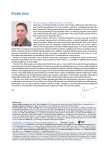Menstrual migraine (migraine without aura): diagnostic and possibility of hormonal treatment
Authors:
Ingrid Niedermayerová
Authors‘ workplace:
Neurologická ambulance Quattromedica, Brno, a Neurologická klinika FN Brno a LF MU
Published in:
Prakt Gyn 2012; 16(1): 27-31
Category:
Contraception
Overview
Migraine is the best known primary headache. It is divided in 2 types:
migraine with aura and migraine without aura. The aura is manifested by visual, sensitive, motoric symptoms or speech disturbances. Menstrual migraine occurs during menses (pure menstrual migraine and menstrually related migraine). By use of combined oral contraception (COC) can occur migraine attack during hormone free interval due to estrogen-withdrawal (oral contraceptive-induced menstrual migraine). Women with menstrual migraine can profit from continual use of COC. Another possibility of treatment is progestogen-only pill. Migraine with aura in females is more likely to worsen due to COC and is higher at risk of migraine stroke, especially with those who smoke. The type of migraine and the age of the women must be respected by the choose of the hormonal contraception.
Key words:
COC – estrogens – hormonal contraception – menstrual migraine – progestins
Sources
1. The International Classification of Headache Disorders. 2nd ed. Cephalgia 2003; 24 (Suppl 1/24): 1–160.
2. Mastík J. Léčba menstruační a perimenstruační migrény. Neurol pro praxi 2008; 9(6): 356–360.
3. O´Brien PM. Helping woman with premenstrual syndrome. BMJ 1993; 30(6917): 1471–1475.
4. MacGregor EA. Menstrual migraine:towards a definition. Cephalalgia 1996; 16(1): 11–21.
5. Silberstein SD, Lipton RB, Dalessio DJ (eds). Wolff´s Headache and Other Head Pain.7th ed. New York: Oxford University Press 2001.
6. Martin VT, Behbehani M. Ovarian hormons and migraine headache: Understanding mechanisms and pathogenesis – part 1. Headache 2006; 46(1): 3–23.
7. Martin VT, Behbehani M. Ovarian hormons and migraine headache: Understanding mechanisms and pathogenesis – part 2. Headache 2006; 46(3): 365–386.
8. De Leo V, Scolaro V, Musacchio MC, Di Sabatino A, Morgante G, Cianci A. Combined oral contraceptives in women with menstrual migraine without aura. Fertil Steril 2011; 96(4): 917–920.
9. Loder EW, Buse DC, Golub JR. Headache and combination estrogen-progestin oral contraceptive: Integrating evidence, guidelines, and clinical practice. Headache 2005; 4(3)5 : 224–231.
10. Allais G, Cabellari IC, De Lorenzo C, Mana O, Benedetto C. Oral contraceptives in migraine therapy. Neurol Sci 2011; 32(Suppl 1): S135–S139.
11. Čepický P. Doporučení WHO k užívání kombinované hormonální antikoncepce 2004. Moderní gynekologie a porodnictví 2005;14(1,Suppl): 11–26.
12. Sannisto T, Kosunen E. Provision of contraception: a survey among primary care physicians in Finland. Acta Obstet Gynecol Scand 2010; 89(5): 636–645.
13. Etminan M, Takkouche B, Isorna FC, Samii A. Risk of ischaemic stroke in people with migraine: Systematic review and meta-analysis of observational studies. BMJ 2005; 330(7482): 63.
14. Bouser MG, Conard J, Kittner Set al. Recommendations on the risk of ischaemic stroke associated with use of combined oral contraceptives and hormone replacement therapy in women with migraine. Cephalalgia 2000; 20(3): 155–156.
15. Lidegaard O, Kreiner S. Contraceptives and cerebral thrombosis: A five-year national case-control study. Contraception 2002; 65(3): 197–205.
16. Fanta M. Kombinovaná hormonální antikoncepce u žen s přidruženým onemocněním. Lék listy 2011; 3, 15–18.
17. Fait T. Antikoncepce. Praha: Maxdorf 2009 : 43–51.
Labels
Paediatric gynaecology Gynaecology and obstetrics Neurology General practitioner for adults Psychiatry Clinical psychology Reproduction medicine Pain managementArticle was published in
Practical Gynecology

2012 Issue 1
Most read in this issue
- Mechanism of implantation of the embryo
- Paravaginal hematoma: case report
- Transfer-factor (IMUNOR) administration in women with chronic vulvovaginal discomfort: clinical study results
- Menstrual migraine (migraine without aura): diagnostic and possibility of hormonal treatment
